Description
Female Betta Koi
Koi Betta are beautiful fish, prized for their marbled colouring. However, their large size can be a challenge for home aquarium hobbyists.
As an alternative, koi bettas combine the beauty of koi fish with the smaller size of bettas.
This care guide will introduce you to the koi betta fish breed, their care, what to expect from males and females, and information about varieties like galaxy koi and koi plakat.
What Is A Koi Betta Fish?
When you see the name koi betta, it’s not surprising if you’re a little confused about exactly what type of fish it is.
A koi betta is not a hybrid of a koi carp and a betta fish. A koi betta is a betta, not a koi. However, a koi betta has a marble coloration similar to the coloration you might find on a koi fish.
Koi bettas are not a different species of betta from other bettas. They’re still Betta splendens (also known as Siamese fighting fish). However, they’ve been bred to have colouring similar to that of a koi fish, just in a smaller, more home-aquarium-friendly size.
Koi bettas are typically white with a combination of black, red, yellow, or orange colour splotches. However, there are fancy versions that also include other colour splotches, such as blue or green.
Compared to other bettas, Koi bettas also tend to be short-finned more often than long-finned.
What Is The Difference Between Koi And Marble Betta Types?
Koi bettas are a variation of marble bettas. As such, koi bettas come in a variety of marbled colour patterns.
Marbling is caused by a “jumping gene” or transposon that makes their colouring unstable. Over the course of their life, the gene switches pigmentation on and off so that the colouring changes with time. Thus, there’s no guarantee that they will keep the same pattern.
Marbling in bettas was discovered in the 1970s by a prison inmate named Orville Gulley. He bred his bettas in peanut butter jars as part of his rehabilitation program at Indiana State Prison. While trying to create a black butterfly betta fish, he accidentally uncovered the marbling gene in bettas instead.
Gulley sent several of his marbled bettas to Walt Maurus, a well-known International Betta Congress hobbyist and betta fish book author. Maurus shared the marbled bettas with other hobbyists who also began breeding them for their marbled patterns.
The first marble bettas were black and white, but today’s are every colour imaginable. The marbling gene expresses itself in fry in unpredictable ways, with new colour and pattern combinations always possible.
If a marble betta is listed as a koi betta, it’s because the marble patterns are similar to that of a koi fish. Koi bettas tend to be more expensive than regular marble bettas. Since their offspring don’t always have the koi patterns, breeding them can have unpredictable results.
Some betta fish enthusiasts say that koi betta colours are also more distinct and sharp than regular marble betta colours.
Some of the more unusual colour combinations in koi betta have resulted in specific koi varieties. Two popular ones are galaxy koi and koi plakat.
Galaxy Koi Betta Fish
The galaxy koi betta is the most common type of koi betta. Their name comes from their iridescent scaling and galaxy-like coloration patterns.
Instead of just the ordinary white, black and red, you’ll find an entire galaxy of colours, including blues, greens, and turquoise.
Male galaxy koi bettas tend to have a base colour that is blue and red dominant. You usually won’t see as many iridescent scales on the males as you will on the females.
Koi Plakat Betta Fish
Koi plakat bettas (like all plakat) have shorter fins and tails than other betta varieties. Their tails are more rounded, making them look less frilly than some betta fish varieties, including the galaxy koi betta.
The koi plakat betta is popular type of plakat because of its ability to have five or more colours on the same fish.
Koi plakat tend to have more cellophane, and iridescent colouring than galaxy koi.
Male And Female Koi Betta Fish
Male and female koi betta fish have the same differences as regular bettas. However, you may find that male koi bettas might have brighter colouring displays when compared to females.
Females often have a more streamlined look than males with their fancy flared fins. They tend to be shorter than their male betta fish counterparts, with wider bodies and shorter fins.
Looking at the ventral fin (the unpaired fin underneath the fish) is another way to tell the difference. Male bettas have wider, longer, and bulkier ventral fins. Meanwhile, females usually (but not always) have thinner and more slender ventral fins.
You can sex a koi betta more reliably by looking for an egg-spot. Females have an egg-spot on their ovipositor, which looks like a white lump past the head and between the two ventral fins. However, if a female is too young, her egg spot may not have developed yet.
How Big Can Koi Betta Get?
Koi bettas can reach up to 3 inches long, which is the same size as regular bettas.
However, if you get a koi plakat, it’s more likely to be on the shorter end of the betta fish size range at 2-3 inches long.
Luckily, koi bettas don’t get as large as their namesake, the koi carp. Koi carp can reach up to 3 feet long rather than 3 inches long.
As such, koi bettas provide the look of a koi in a much smaller package that is easy to accommodate in an indoor home aquarium.
Koi Betta Fish Temperament
The betta nickname of Siamese fighting fish comes from the tendency of bettas to be highly territorial and aggressive. Koi betta temperament is no different than that of other bettas.
You will never want to house two male koi bettas together because they will often fight to the death.
Housing a single male and single female koi betta together can also result in death from aggressive mating chases.
Adding new fish to a koi betta’s tank can cause it to feel like its territory is being invaded, which can cause aggression. Instead, you want to add a koi betta to an established tank so that it’s the new kid on the block and doesn’t feel that it owns all tank territory.
Of course, every koi betta is different. There’s the chance that your koi betta fish won’t tolerate any tank mate. So, proceed with caution, especially if you have a male.
Koi Betta Tank Mates
Bettas are best kept alone. However, if want to try housing them with others, it’s best to keep them with peaceful, tropical fish with dull colours and short fins. You wouldn’t want to house them with any fish that they could mistake for a rival betta fish, like an endler guppy.
When you think about betta fish tank mates, you have to consider how many fish your tank will hold. The rule of thumb is that a tank can hold one inch of fish per gallon of water.
Subtract three (the length in inches of a betta) from the number of gallons your tank will hold to determine how many more inches of fish your tank can handle.
Many common betta fish tankmates are also schooling fish, so you’ll need to consider if you have enough room in your tank for the minimum schooling size.
Fish that get along well with koi betta fish as tankmates include:
- Harlequin rasbora: school of 6+, 2 inches each, 15-gallon minimum
- Ember tetra: school of 7+, 0.8 inches each, 15-gallon minimum
- Bristlenose pleco: one only, 5 inches, 20-gallon minimum
- Clown pleco: one only, 4 inches, 20-gallon minimum
- Kuhli loach: school of 4+, 5 inches each, 25-gallon minimum
- Amano shrimp: school of 2+, 2 inches each, 5-gallon minimum tank
- Snail (any variety): any number, 1-5 inches each, 10-gallon minimum tank
- Oto catfish: school of 3+, 2 inches each, 10-gallon minimum tank
- Cory catfish (any variety): school of 5+, 1-4 inches, 25-gallon minimum tank
Sorority Tanks
If you want a tank that resembles a miniature indoor version of a koi carp tank, an all-female koi betta sorority tank is a good choice.
The success or failure of a sorority tank depends on the personality of the fish that you house together, how big your tank is, how well your tank is planted with foliage, and the way you introduce your fish.
The aggressive nature of bettas requires that you have 3-5 gallons of aquarium space per fish. The tank should be heavily planted or decorated to create separate spaces for each female to claim as their own and hide from others.
Introduce all your bettas at once to prevent infringing on pre-established territories. After they’ve established their hierarchy and territories, the aggression should stop. However, if it doesn’t, you’ll either want to remove them all, rearrange the tank, and try a reset by adding them all in again. Alternately, you can just remove the aggressive ones.
Koi Betta Fish Care
Caring for bettas is fairly simple. Let’s look at what they eat and how to set up their tank.
What Do Koi Betta Eat?
In the wild, bettas mainly feed on insects and insect larvae. While it’s fine to feed them with pellet or flake fish food, they’re even happier with frozen or live dietary supplements, including:
- Bloodworms
- Mosquito larvae
- Brine shrimp
- Daphnia
How To Set Up A Suitable Koi Betta Fish Tank (Tank Requirements)
Single bettas are the perfect fish for nano tanks. Since they’re best alone, they don’t need tons of space, making them one of the best fish for small desktop tanks.
Of course, any fish appreciates a larger tank for more swimming room.
Tank conditions should be as follows:
- pH: 6.0 to 8.0
- Water hardness: soft water
- Tank size: 3 gallons minimum
- Temperature: 75°-84°. Bettas are tropical fish, and unheated tanks stress the fish, making them more susceptible to disease and shortening their lifespans.
- Plants: Koi bettas like planted tanks. If you house them with other fish, plants give them a place to hide. Hardy plants like anubias, java ferns, cabomba, and water sprite are great choices. Floating plants like duck weed are also a good option.
- Water movement: Filters should provide minimal water movement to mimic their natural habitat. Frequent water changes suffice in nano tanks instead of filters.
Breeding Koi Betta
Koi bettas breed most successfully when they’re 4-12 months old. Breeding before age 14 months ensures the healthiest fry and the best genetics.
The best breeding stock are healthy and have the brightest colours and most elaborate fins. Red-coloured male koi betta fish are the most attractive to female koi bettas.
Here are the tank parameters for mating:
- Depth: 3-5 inches allows fry to reach the surface more easily later
- Decorations: Provides privacy during mating
- Temperature: 76°-84°F
- pH: 6.0-7.0
Add the female to the breeder tank at least an hour before the male. Then, add the male to the tank end that doesn’t contain the female. A divider can help each fish settle better.
The male will flare its fins and display more vivid colours. When ready for mating, the female will do the same and display her vertical barring pattern. After this signal, the male will build a bubble nest. If the female approves, the mating process will begin.
The mating process will last 4-6 hours. You should monitor them closely during this time. If the female looks stressed from all the chasing and biting, you can add extra decorations for hiding or remove her altogether.
Keep the tank slightly humid to help the eggs hatch. The best way to do this is to cover the tank.
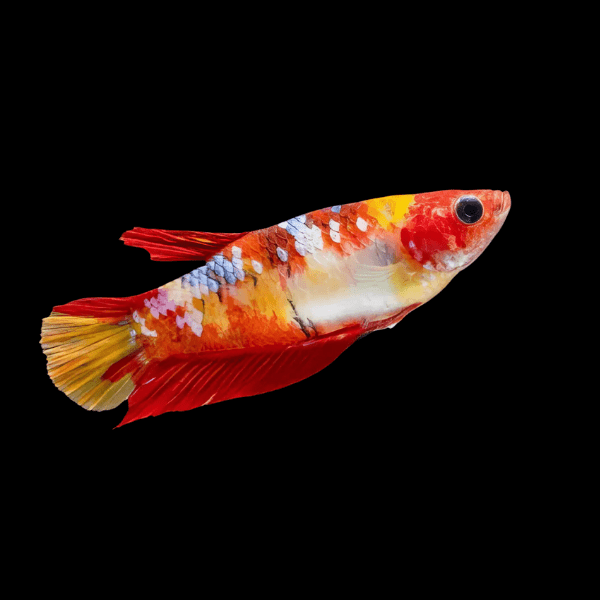

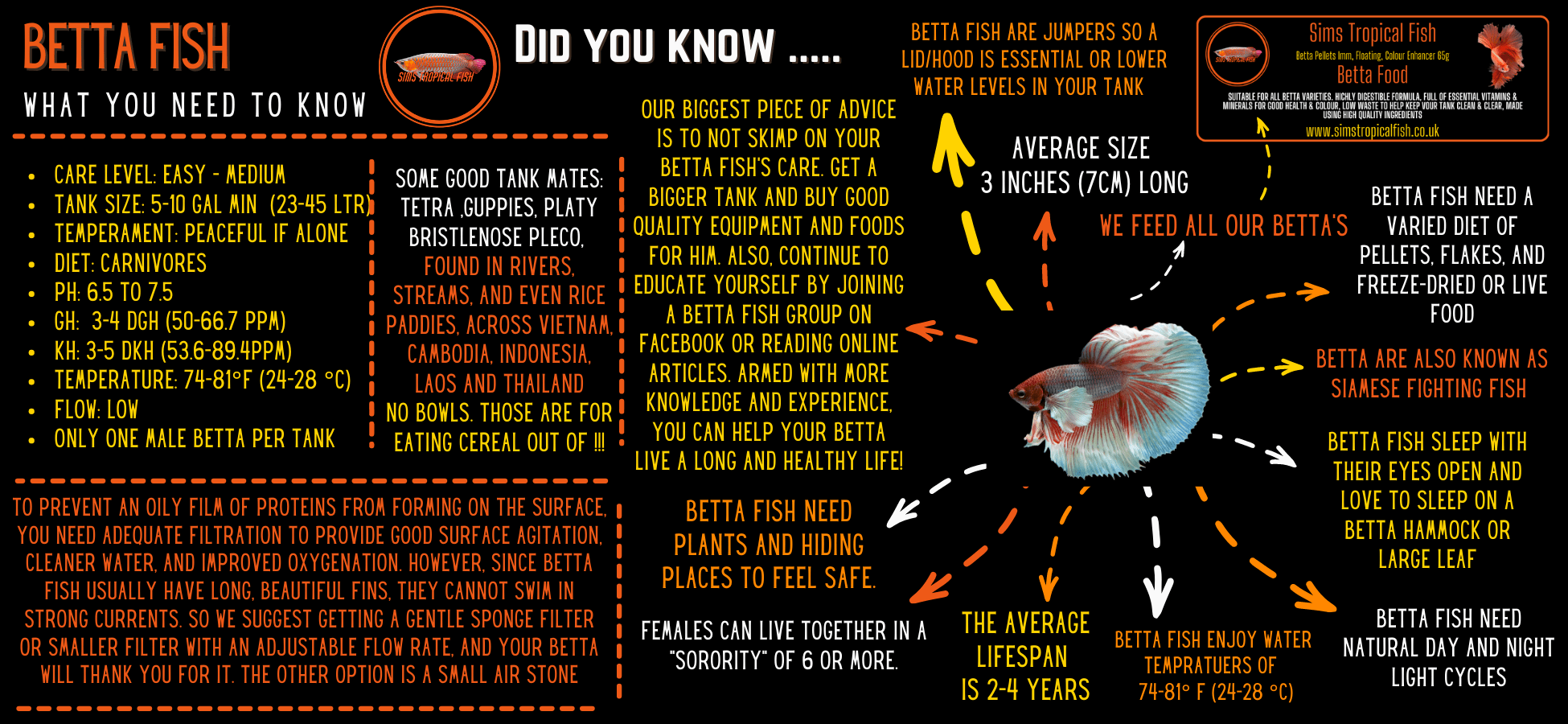
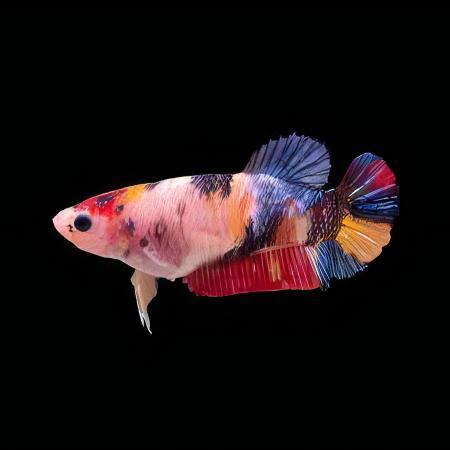
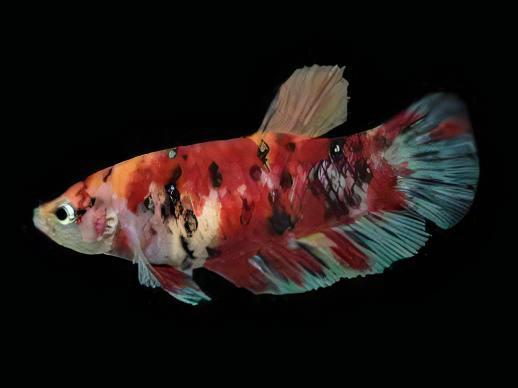
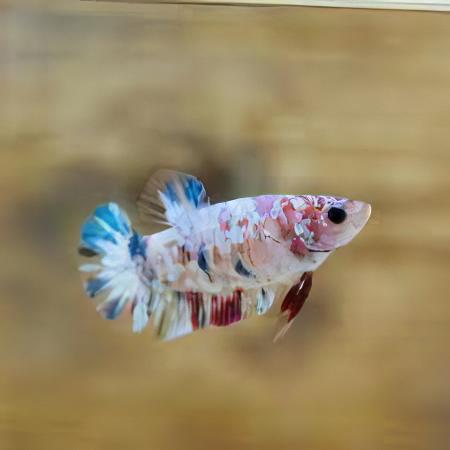
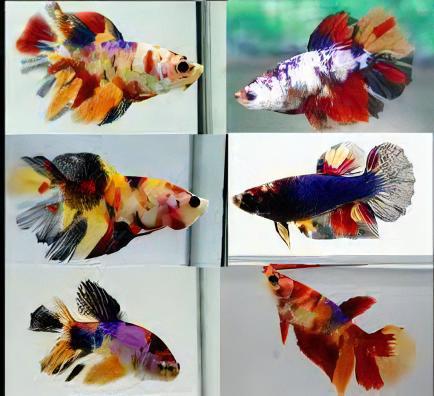
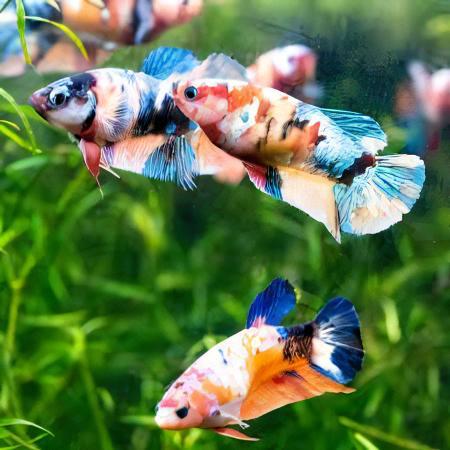

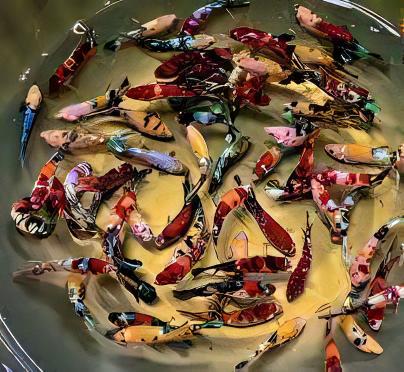
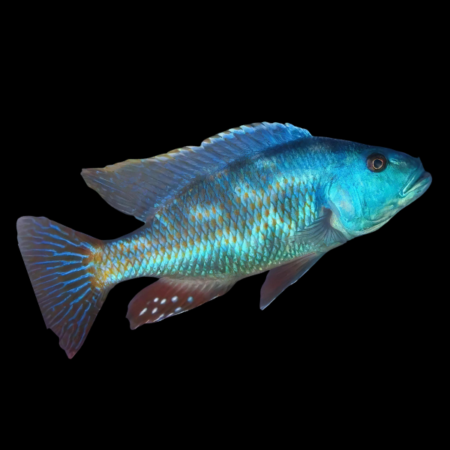
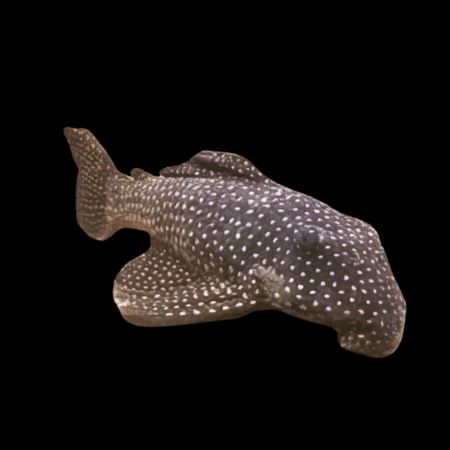
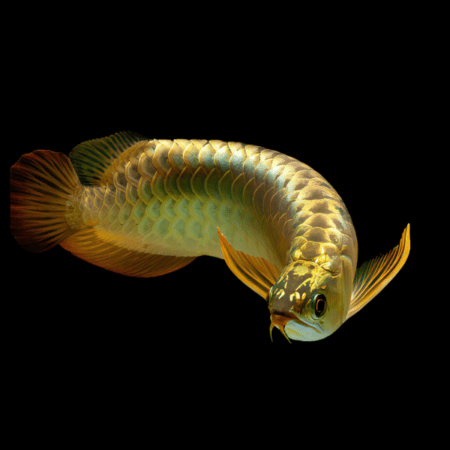

Reviews
There are no reviews yet.